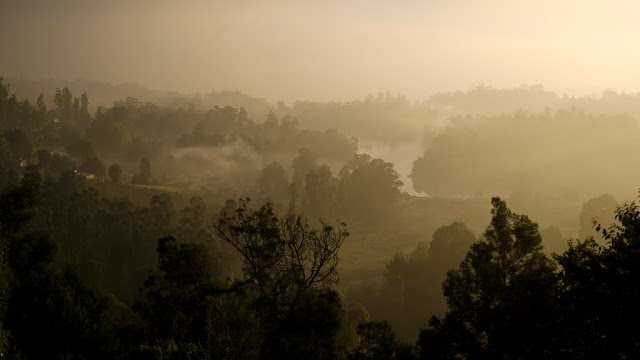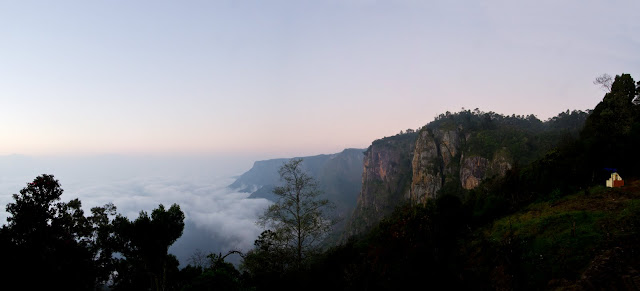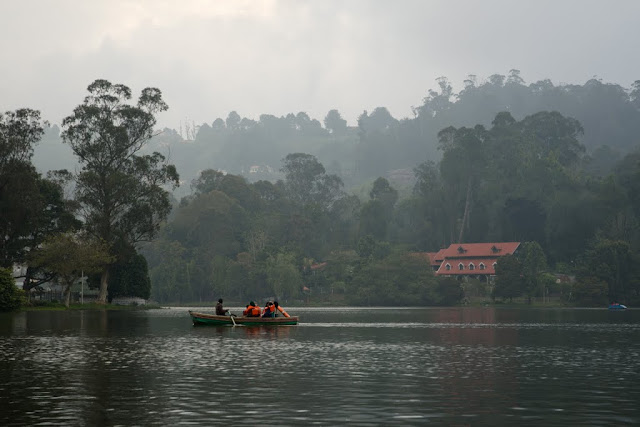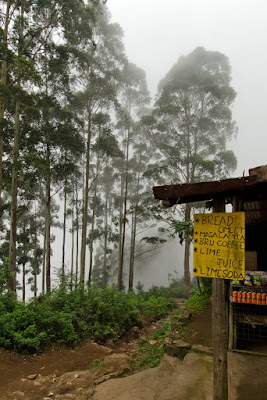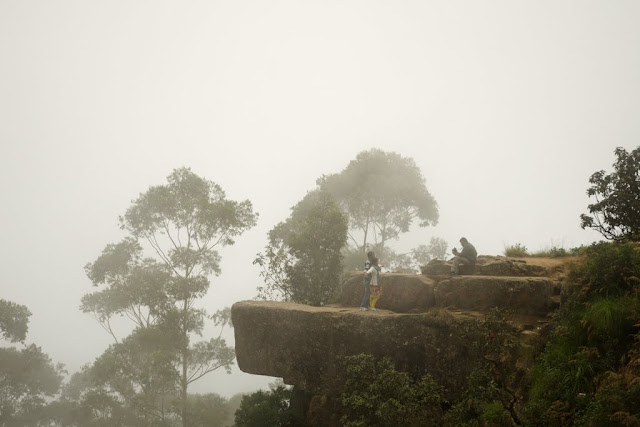Published in the August 2016 edition of Discover
India magazine, as 'The Big Misty'.
The fireplace
crackled, spewing out untamed flames, and sparks that spat into the room like energetic
fireflies. I smiled and sank deeper into my easy-chair, cupping a bowl of hot soup.
I was enjoying every bit of the cold weather, having arrived here from the scorching
plains. Just a few relaxing hours in Kodaikanal had afflicted me with a languor
that was quickly becoming second nature. As my hosts spoke animatedly about
life in Kodaikanal, their favourite long walks, secret nooks, and scenic views,
it became abundantly clear that I had a battle on my hands to shake off my slothfulness,
if I wanted to explore Kodaikanal.
Sepia-tinted
photographs and meticulous black-and-white sketches from the 1800s, dotted all
over my hosts’ living room, enticed me with the promise of pristine landscapes,
fleet-footed Nilgiri Tahrs and Sambar deer in grasslands, and humungous Gaurs
surprising me at road bends. As a compulsive nostalgia seeker, the thought of attempting
to experience 19th century Kodaikanal immediately caught my fancy,
and soon, I was consumed by the idea. So I pored over the photographs and
sketches, noted details, and armed myself with directions and tips from my
hosts, to help me recreate the memories held by these images.
 |
| Morning dew on my window |
The next morning, I forced
myself out of the snug comfort of my quilt, only to be greeted by the croaking
of cicadas. When I left at 6 am, there was barely enough light to discern and
open the padlock on the property’s gate, while simultaneously trying to prevent
their resident pet from running out with me.
Kodaikanal had not yet awoken from its slumber, except for a dimly-lit
tea shack from which wisps of smoke emanated.
From its viewpoint, Kodaikanal
Lake was seen shrouded in mist, which had coagulated over the water like gigantic,
unruly candy floss. All around, trees emerged, many of them distinctly pine and
eucalyptus. The sunrise vista was like watching film slowly develop in a
dark-room: monochromatic at first, segueing from pastel pink to sepia, with the
other colours choosing to reveal themselves only an hour later, as I drove back
past the viewpoint. The lake’s shape as seen from here corresponds exactly to
its 19th century photograph. Not much has changed in the view,
barring low roofs of Kodaikanal town peeking out from between layers of trees.
 Pillar Rocks lay at
the end of a long, winding drive from the lake’s viewpoint; save for a couple
of houses, the road was deserted. Crepuscular rays streamed in through thickets
of trees, from which I heard langurs swinging. I was shaken out of my reverie
by the appearance of a barricade - the road hadn’t yet been opened to vehicles
for the day. I approached Pillar Rocks on
foot, with heightened anticipation.
Pillar Rocks lay at
the end of a long, winding drive from the lake’s viewpoint; save for a couple
of houses, the road was deserted. Crepuscular rays streamed in through thickets
of trees, from which I heard langurs swinging. I was shaken out of my reverie
by the appearance of a barricade - the road hadn’t yet been opened to vehicles
for the day. I approached Pillar Rocks on
foot, with heightened anticipation. |
| Pillar Rocks sketch by Douglas Hamilton, 1862. Source: Wikipedia. Larger image: click here |
The valley, however,
lived up to its promise of being mist-filled, revealing parts of the escarpment
of the Palani Hills on which Kodaikanal is situated. A howling, bone-rattling
wind made my jacket and gloves redundant, but helped clear the clouds; the sky then
turned a picture-postcard blue and gifted me the sight of Pillar Rocks crowned
by the setting moon. When I said gifted, I meant it – just a few hours later, eager
visitors to Pillar Rocks saw nothing, as fog hid the rocks until the next sunrise.
My hosts had been right in egging me on to leave before dawn.
Enthused by how my morning
had panned out, I was less averse to exploring ‘modern’ Kodaikanal and decided to
see the picturesque lake up-close. The lake is the focal point of life in
Kodaikanal, for residents and visitors alike. With restricted vehicular
movement on the road encircling the lake, it comes alive with cyclists whizzing
past, people chatting, residents jogging, and couples enjoying quiet strolls.
With the lake on one side and many palatial heritage buildings lining the
other, the lake road exudes an old-world charm.
The sight of bicycles
brought out the child in me and I spent a greater part of the afternoon
giggling over our clumsy tandem-bike riding skills, while resolutely cycling
around the lake. To perhaps continue kindling the child in you, the boat clubs
have ensured that most pedal-boats have gigantic cartoon characters built on
them. With Mickey Mouse for company, I pedalled across the lake to one of its
quieter arms. Families had turned up in droves to enjoy the pleasant evening;
in spite of the crowd, the large size of the lake allowed me to have a piece of
Kodaikanal to myself. And I had to admit - the Kodaikanal of today had provided
me with as much excitement and relaxation as the Kodaikanal of the past.
That didn’t stop me
from resuming my pursuance of the next black-and-white photograph, though. Dolphin’s
Nose, so named because of the shape of the rock overhanging the valley, promised
an interesting trek, and I decided to undertake it early the next day. The
narrow trail took me past bustling hutments, cheap lodges with bewildering Hebrew
signage, refreshment stalls, and locals gathering firewood, before meandering
through trees and losing all sight of habitation. Which is why, it startled me to hear a voice
behind me say “photo, madam?” barely ten minutes after I sat near the edge,
lost in quiet contemplation.
Once an Enid
Blyton-esque picnic spot for Kodaikanal’s residents, Dolphin’s Nose now attracts
many visitors who enjoy posing in the ‘Titanic pose’ at the very edge. A few
enterprising photographers not only orchestrate photogenic poses, but are also
equipped with instant printers to give you copies within minutes. Upon my
refusal, the photographer too sat down to admire the view. Coaxed by him into experiencing
the feeling of sitting at the actual end, I slowly overcame my fear and swung
my legs over the edge, hands gripping the ground next to me for dear life. Though
decades had elapsed since my reference colonial era photo had been taken, Dolphin’s
Nose still felt like the end of the world.
If Dolphin’s Nose
whetted my appetite for more solitude, Berijam Lake surpassed it. With highly
restricted access to the lake, you are almost guaranteed to be the sole
individual there if you time it right. The long drive to the lake passes
through precariously surviving shola-grasslands; I was pleased because it
increased my chances of spotting wildlife, if not the elusive Tahrs. Mist
engulfed the road for quite some time, considerately lifting at just the right
viewpoints.
Berijam Lake sat in the valley like the grand prize at the end of a
journey. To stroll and sit at the water’s edge, surrounded by hillocks and
dense clusters of conifers, with no sign of ‘civilisation’ in sight, made it
the perfect end to my quest for nostalgia.
Driving back from
Berijam Lake, lamenting that it was time for me to leave Kodaikanal, I passed
the golf course. Despite being mid-day, mist rolled over its gentle undulations,
even as a lone golfer persistently played his game.
That is when it dawned on me - the 19th
century still existed in Kodaikanal: in its pristine landscapes, its capacity
to offer solitude, and its flair for surprising you. And then, almost as if to
chide that obsessing about the past wasn’t healthy, Kodaikanal drops a misty
curtain on it all, nudging visitors to experience its present – its people, its
lake, and its activities. I realised that Kodaikanal morphs into what you seek
from it.


